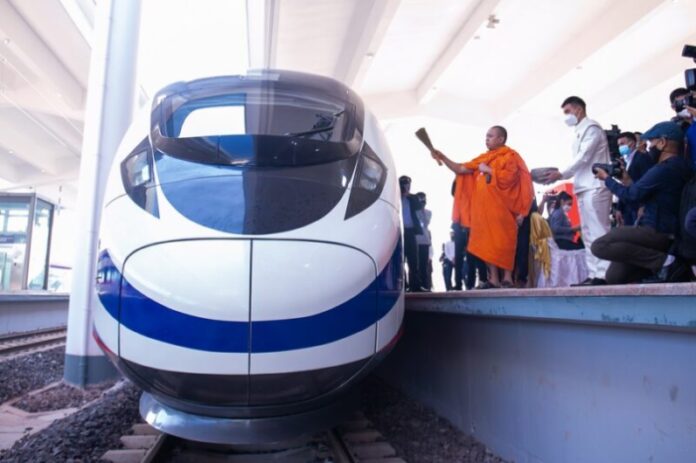
-
One year on, the China-Laos Railway has realized land-locked Laos’ dream of becoming a key land transport hub, Xinhua reports
-
The railway had carried around 2 million tons of goods including 1.6 million tons of cross-border commodities, and 1.3 million by early December
-
Train tickets are in high demand, especially from tourists from neighboring countries like Thailand who are eager to ride a high-speed electric multiple unit train
One-year-old China-Laos Railway has turned Laos into an important transport hub in the Association of the Southeast Asian Nations, bringing great benefits to the Lao people as it opened up a new path for the country’s development and prosperity, according to a Xinhua report.
Laos, ASEAN’s only landlocked member, has realized its dream of becoming an ASEAN land transport hub, thanks to the railway’s streamlined China-standard bullet train service between the Lao capital Vientiane and the industrial Chinese city of Kunming in Yunnan province.
RELATED READ: Railway to Vietnam spurs Laos logistics hub goal
The railway was launched on December 3, 2021 by Lao President Thongloun Sisoulith, who described the project as a monumental and historic milestone in the development of modern infrastructure for Laos. He called the event “a proud moment and the dream of all ethnic groups of Laos,” Xinhua reported
The Chinese state news agency said Lao Deputy Prime Minister Sonexay Siphandone, marking the first anniversary of China-Laos Railway, hailed the quality rail service for passenger and freight transportation and its contribution to the socio-economic development of Laos.
Siphandone said the railway has greatly enhanced his country’s international strategic position, turning Laos into an important hub for transportation in the region.
RELATED READ: Thailand, Malaysia agree on hi-speed railway to China
The railway had carried a total of around 2 million tons of goods, including some 1.6 million tons of cross-border commodities as of early December, according to Xinhua.
Freight transport has become a rising trend with cargo categories expanding to more than 1,200 categories. Goods such as daily life commodities, fertilizers, electronics, photovoltaics, textiles and vegetables, among others, were shipped from China to Laos, while iron and zinc ore, cassava flour, barley rice, charcoal, rubber, potash and fruits were transported from Laos and neighboring countries to China.
Xinhua said that earlier in 2022, Hunan Province in central China and Laos’ Ministry of Agriculture and Forestry signed a memorandum of understanding to build jointly the “One Way, Two Parks” project.
The two sides will use the China-Laos Railway to strengthen comprehensively their international agricultural cooperation, as well as economic and trade exchanges by linking up Vientiane’s modern agricultural industrial park and related industrial parks in Hunan.
“We are among the beneficiaries of the railway,” Xinhua quoted Xu Guowu, chairman of Xuanye (Laos) Co. Ltd., from Hunan Province. His company helped Laos officially export its first batch of rice to China in 2015, opening a new market for Lao rice exports.
On Dec. 7 this year, Xu saw off a special freight train carrying 25 cold-chain containers loaded with Xuanye’s 500 tons of fresh Lao bananas to Changsha, the capital of Hunan Province.
Xinhua said this was the first “banana train” that travels directly to a specific Chinese city since the China-Laos Railway was launched. “The railway brings more businesses coming true,” Xu said.
By December, the railway had carried about 1.3 million passengers as it shortened traveling time between cities along the route, enabling its population to seek education, visit families, or receive medical attention a lot faster and easier.
Xinhua said Kingkeo Duangphanam, 33, from northern Luang Prabang province previously traveled eight to nine hours by bus to Vientiane. Now she journeys in comfort for only two hours by rail.
The railway helped revive Laso’ tourism as demand from passengers traveling from Vientiane to Luang Prabang is growing.
Xinhua quoted Du Zhigang, operations director of Vientiane-based Laos-China Railway Co. Ltd. joint venture that runs China-Laos Railway’s Lao section, said train tickets are in high demand, especially from Thai tourists and other neighboring countries who are eager to ride a high-speed train.
The railway’s Lao section has created over 110,000 jobs for Laotians and attracted numerous Chinese and local young talent who pursue their professional careers on the railway.
While the railway was still under construction, the Laos-China Railway had opened a training course for around 600 Lao trainees to learn train driving, scheduling and maintenance.
Sida Phengphongsawanh, 23, a woman who became a locomotive maintenance engineer after undergoing a series of training courses, told Xinhua in a recent interview that working and spending time together have brought her and her Chinese colleagues closer.




